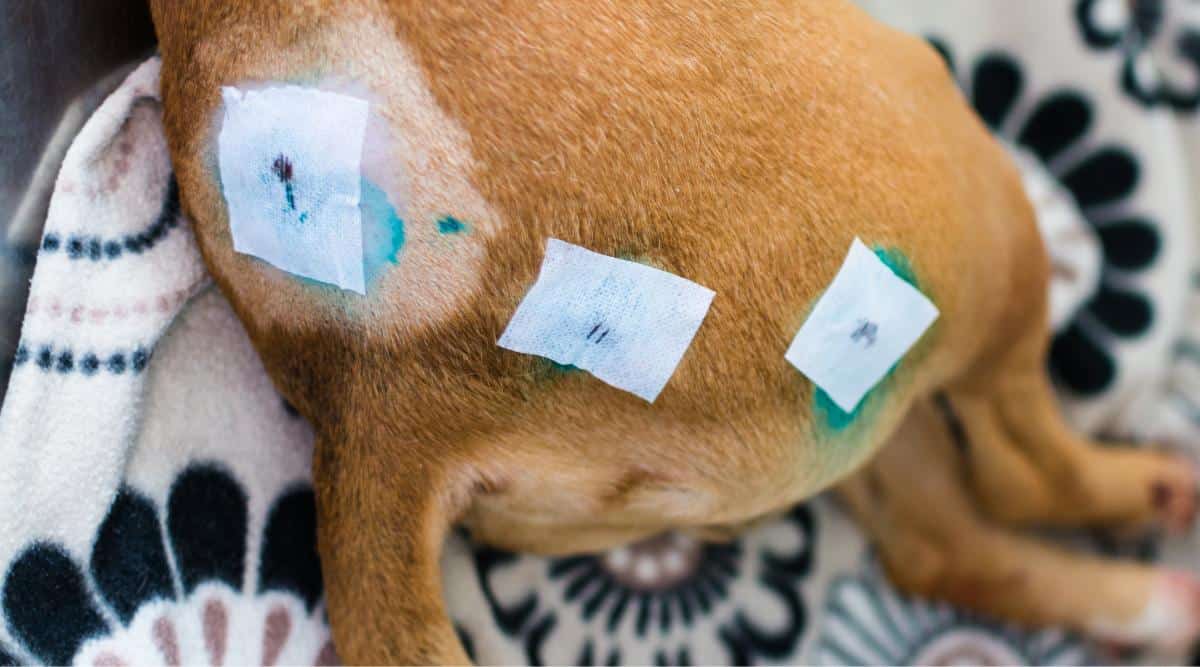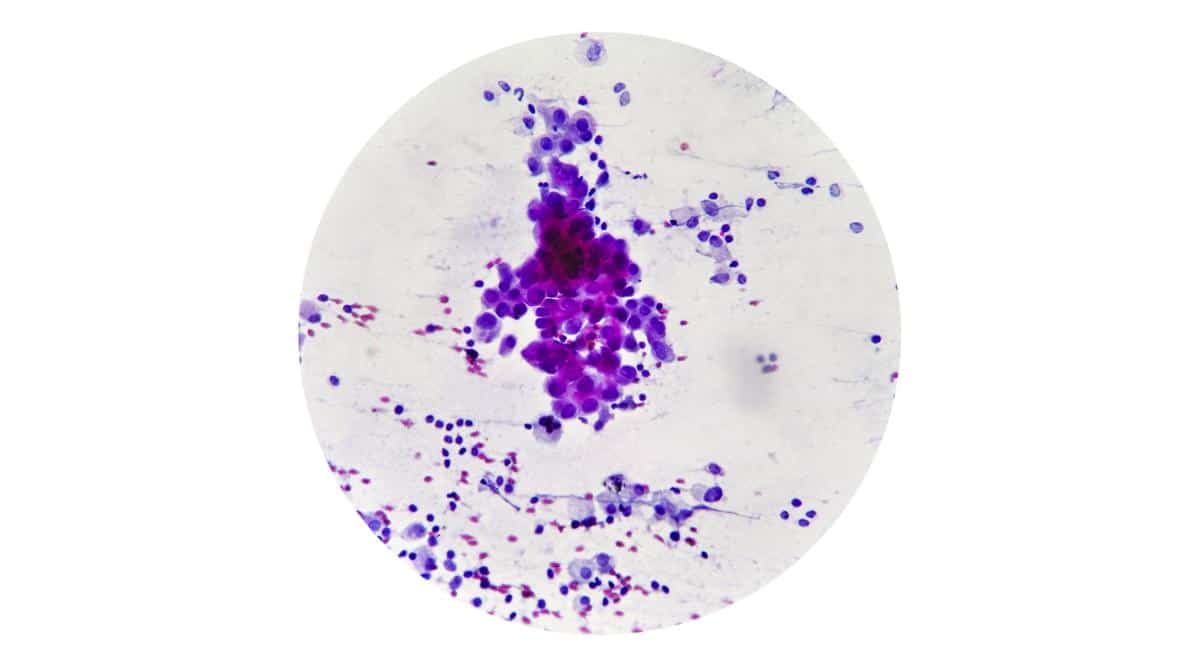
To keep the lights on, we receive affiliate commissions via some of our links. Our review process.

Lumps and bumps are common in our canine friends as they age and can vary hugely in their severity. As a pet parent keeping your furry friend happy and healthy is a top priority, so finding a new lump or growth on their body can be a worrying time. If your dog has been diagnosed with fibrosarcoma by a veterinary professional, you may be confused and worried. Let’s learn more about this type of tumor, what causes them, and what can be done about it.
What Are Fibrosarcomas?
Contents

A fibrosarcoma is a malignant (cancerous) tumor that develops from the uncontrolled growth of cells called fibroblasts. Connective tissue is the tissue in the body that connects, supports, or separates tissues and organs such as tendons, ligaments, and skin. Fibrosarcomas occur most commonly in the connective tissue of the skin or beneath the skin.
Fibrosarcomas are a type of soft tissue sarcoma. They are sometimes referred to as ‘spindle cell sarcomas in dogs’ as the fibroblast cell has a thin, spindle-like shape. They are most commonly found on the legs or digits of dogs or the body. They can also be found in the nasal cavity or mouth of dogs and can invade the jawbone. In rare cases, fibrosarcomas originate from the bone or joints, causing a primary form of bone cancer.
What Causes Fibrosarcomas In Dogs?
The cause of fibrosarcoma in dogs is unknown, and like most cancers in dogs, fibrosarcoma is a complex disorder, and many factors can predispose it to its development. Cancerous tumors are caused by a random mutation in the genes of a cell as they divide to replace themselves, resulting in uncontrolled growth.
Some external factors such as nutrition, tobacco smoke, pesticides, UV light, and pollution can increase the chance of these mutations and tumor formation. Fibrosarcomas are more common in larger breeds of dogs, so there may be a genetic cause of this disease.
Fibrosarcoma In Dogs Symptoms
The symptoms of fibrosarcoma in dogs vary depending on the tumor’s location, size, and how advanced the tumor is.
Oral Fibrosarcoma In Dogs
Fibrosarcoma in a dog’s mouth typically presents as a mass in the mouth. These can be difficult to spot, especially if they occur at the back of the mouth. Dogs may bleed from their mouth, drool more than normal, or have bad breath. Some dogs may display pain when eating or change the way they eat such as chewing on one side of the mouth only or taking longer to finish their dinner. Dogs with oral pain may not play with toys or catch balls as much as they used to.
Nasal Fibrosarcoma In Dogs
A fibrosarcoma in the nasal passages may affect your dog’s breathing. They may cause nose bleeds or a discharge from the nostrils on one or both sides. Sometimes a mass may be palpable on the outside of the nose or muzzle, or your dog’s face may look asymmetrical or swollen on one side. Large fibrosarcomas in the nose may affect the flow of air resulting in snoring or difficulty exercising.
Skin Fibrosarcoma In Dogs
Fibrosarcomas may present as a lump or bump anywhere on the body. They can grow on top of, or underneath, the skin. These tumors can be as small as the size of a pea or grow to a considerable size such as the size of a tennis ball. The skin overlying the tumor may be smooth or ulcerated and, in some cases, secondary infections can develop.
Bone Fibrosarcoma In Dogs
Fibrosarcomas that affect the legs or joints of dogs can be very painful and progress rapidly. Tumors on the legs of dogs can cause lameness, weakness, or difficulty lying down. A swelling or lump may be felt on your dog’s leg or around the joints.
Fibrosarcoma In Dogs Diagnosis
If your dog has a new lump or bump or is displaying any of the symptoms discussed, then don’t delay in seeking veterinary advice. Your vet will perform an examination of your pet and may also take blood and urine samples to assess their health. A diagnosis of fibrosarcoma can only be made following an examination of the tissue by a pathologist.
A sample of the cells in the tumor is collected by a needle biopsy (known as fine needle aspiration or FNA) or a surgical biopsy. Diagnostic tests such as x rays or a CT scan may be needed to assess the extent of the tumor and whether it has invaded the bone. Nasal fibrosarcomas may be diagnosed using rhinoscopy, a camera study that is performed under general anesthesia.
Fibrosarcoma In Dogs Treatment
Surgical removal of the tumor is the preferred treatment for fibrosarcoma in dogs. Surgery involves removing margins of normal tissue around the tumor to reduce the risk of recurrence. However, because of this tumor’s location and invasive nature, complete surgical removal is often not possible, and recurrence is common. For tumors that affect the nasal cavity or mouth of dogs, surgery may involve removing part of the jawbone. Tumors of the leg bones are generally more aggressive, and amputation of the affected limb may be recommended.
Radiotherapy is sometimes used before surgery to shrink the tumor size or for tumors that cannot be removed surgically, such as nasal fibrosarcomas. Radiotherapy may also be used after surgery if your vet is concerned cancer cells may have been left behind to try and reduce the risk of the tumor re-occurring. In general, fibrosarcomas are poorly responsive to chemotherapy.
Natural Treatment For Fibrosarcoma In Dogs
Home remedies are unlikely to help fibrosarcomas in dogs or rid them of the disease. However, home remedies may be useful when your dog is recovering from surgery. Ointments such as arnica cream can be used on surgical sites to help heal tissue trauma and bruising. However, it is best to check with your vet when it is safe to give this to your dog after surgery.
Providing plenty of rest and comfortable space for your dog to recover after surgery is important. Slings and harnesses may be used at home to help your dog get up and go to the toilet if they struggle with mobility after surgery. Bodywork or massage may be useful to help release deeper tension following surgery, but only start this after your vet has given the go-ahead. Natural probiotics are also very useful in the postoperative period to help rebalance your dog’s gut bacteria following anesthesia and other drugs.
Fibrosarcoma In Dogs Prognosis
The prognosis for fibrosarcoma in dogs varies depending on their location, size, and whether or not they can be completely removed with surgery. Every dog will have their own set of specific circumstances that will affect its prognosis.
While the chance of metastasis (spread) to other areas of the body is low for fibrosarcoma, this type of tumor is very likely to eventually return, even with treatment. Fibrosarcomas that occur under the skin carry the best prognosis, whereas tumors of the bones carry the worst prognosis. Treating oral and nasal fibrosarcoma with surgery and/or radiation will likely extend your dog’s life by 6 to 18 months.
Fibrosarcoma In Dogs Life Expectancy
Depending on the size and location of the fibrosarcoma, treatment can be curative. In some cases, removing the tumor is not possible, and treatment is designed to improve your dog’s quality of life and extend your time together as much as possible.
The life expectancy of dogs with fibrosarcoma will depend on the location of the tumor, its grade, and whether it has invaded bone or spread to lymph nodes nearby. Low-grade tumors may grow very slowly over months to years and only cause a problem due to their size, affecting how your dog moves his legs or becoming ulcerated and painful.
Canines With Cancer
Fibrosarcomas are a common tumor in dogs. They are malignant and can be invasive at the point where they occur, but they rarely metastasize (spread) to other areas of the body. Learning that your dog has fibrosarcoma can be a worrying time. However, with prompt treatment, favorable outcomes are possible, even if the treatment is not curative. If you are concerned about a new lump or swelling on your dog, then call your vet and get your pooch checked out as soon as possible. The sooner they are diagnosed, the sooner they can be treated and get back to their usual antics. Find out more about the signs of cancer in dogs and if pet insurance can help cover the costs.
Tagged With: Cancer